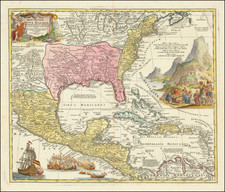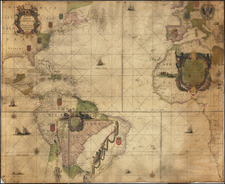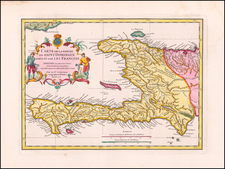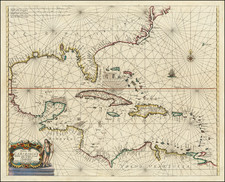Extremely rare separately pubished map of the Island of St. Eustatius, published in 1795 in London by William Faden.\
The map includes fine topographical details, as well as plantations, roads and artillery battery. In
The map was engraved by Thomas Foot, the principal engraver to the Board of Ordnance.
St. Eustatius
The island of St Eustatius was first discovered by Christopher Columbus on his voyage of 1493. Over the following 150 years, it was claimed by many colonizing European empires, although the island was not formally settled until 1636 when it was officially taken by the Dutch. Along with St Maarteen and Saba, St Eustatius made up the Dutch Antilles. The Dutch began cultivating tobacco and sugar on St Eustatius to export back to Europe.
By the end of the 18th century, the port town of Oranjestad had grown in importance, as St Eustatius found itself located in the center of a host of other islands claimed by European empires, such as the British, French, Spanish, and Danish. In 1756, Oranjestad was claimed as a free port with no customs duties, making it a major point for the trans-shipment of goods in the Caribbean, and earning the island the nickname of the ‘Golden Rock’.
Due to its free port status, the island was also a hub for contraband, and the country became a major arms dealer as it was willing to sell on imported arms and ammunitions to anyone. In the late 18th century, St. Eustatius served as a crucial way station for supplying the Continental Army with supplies, as a means of bypassing the British blockade.
In 1776, St. Eustatius became the first foreign port to salute the flag of the United States, when the ship Andrew Doria arrived to purchase supplies as well as to present the Dutch governor of the island with a copy of the US Declaration of Independence. This friendly relationship with the colonies made St. Eustatius a target for the British, who blamed the trade between them for Britain's failure to quickly win the war.
On January 30, 1781, Admiral Sir George Rodney set out with 30,000 British troops to capture the island of St. Eustatius and put an end to trade with the colonies. Rather than launching an immediate assault, Rodney sent word to Governor Johannes de Graaff asking for a peaceful surrender. De Graaff agreed and by the next day the nearby islands of St. Maarten and Saba had also surrendered to the British troops.
Rodney and General John Vaughan had signed an agreement whereby all confiscated goods would go to the British Crown, and they in turn expected to receive a significant percentage upon their arrival in England. Rather than delegating the task of appraising the plunder, Rodney and Vaughan did it themselves, holding a public auction of the seized goods, including naval and military stores, open to buyers of any nationality including the French and the Americans, who were able to purchase goods from the British for about half the price they would have paid had they bought them from the Dutch. When the British caught wind of this, Rodney and Vaughan were charged with privateering.
St. Eustatius at the time was a vibrant, multicultural community that included African slaves, British citizens, American loyalists, and a significant Jewish community. "The Jews suffered the harshest treatment even though some of them were British. The Jewish community at St. Eustatius was made up of some 350 Sephardic and Ashkenazim members. With the support of their brethren in Curacao and Amsterdam, they had built a synagogue, which they called Honen Dalim, meaning 'the one who is merciful to the poor,' of which there are still remains in St. Eustatius…
"The conquest of St. Eustatius was 'a day of desolation to the community at large & Jews in particular.' The Jews shared in the common 'Loss of their Merchandise, their Bills, their Houses, Clothes, [and] Provisions' but they alone suffered the separation of families and the banishment of their men who were not even told the destination of their exile. They 'petitioned, intreated, implored, [and] remonstrated against so hard a sentence, but in vain.' They were not allowed to keep their personal possessions, in contrast to the Americans, Dutch, and French. Those found withholding petty cash were set apart for punishment. The 101 adult male Jews were assembled under guard and had the linings of their pockets ripped open and their 'cloaths torn in pieces to search for concealed money' before thirty of them were 'hurried off the island, destitute of everything, to solicit the cold charity of Antigua, and St. Kitts.' The rest were locked in a weighing house for three days; they were released just in time to witness the auction of their belongings"
The island was later re=conquered by the French, allies of the Dutch, and regained by the Netherlands in 1784. By 1795, the Dutch and French were no longer allies and, for the next 20 years, the country swapped hands between the French and British 22 times. St Eustatius has remained in Dutch hands ever since and, in 2010, it was given the status of ‘special municipality’ of the Netherlands following the break-up of the Dutch Antilles.
William Faden (1749-1836) was the most prominent London mapmaker and publisher of the late-eighteenth and early-nineteenth centuries. His father, William Mackfaden, was a printer who dropped the first part of his last name due to the Jacobite rising of 1745.
Apprenticed to an engraver in the Clothworkers' Company, he was made free of the Company in August of 1771. He entered into a partnership with the family of Thomas Jeffreys, a prolific and well-respected mapmaker who had recently died in 1771. This partnership lasted until 1776.
Also in 1776, Faden joined the Society of Civil Engineers, which later changed its name to the Smeatonian Society of Civil Engineers. The Smeatonians operated as an elite, yet practical, dining club and his membership led Faden to several engineering publications, including canal plans and plans of other new engineering projects.
Faden's star rose during the American Revolution, when he produced popular maps and atlases focused on the American colonies and the battles that raged within them. In 1783, just as the war ended, Faden inherited his father's estate, allowing him to fully control his business and expand it; in the same year he gained the title "Geographer in Ordinary to his Majesty."
Faden also commanded a large stock of British county maps, which made him attractive as a partner to the Ordnance Survey; he published the first Ordnance map in 1801, a map of Kent. The Admiralty also admired his work and acquired some of his plates which were re-issued as official naval charts.
Faden was renowned for his ingenuity as well as his business acumen. In 1796 he was awarded a gold medal by the Society of Arts. With his brother-in-law, the astronomer and painter John Russell, he created the first extant lunar globe.
After retiring in 1823 the lucrative business passed to James Wyld, a former apprentice. He died in Shepperton in 1826, leaving a large estate.













![Indigotoire [Indigo Plantation]](https://storage.googleapis.com/raremaps/img/small/92080.jpg)
